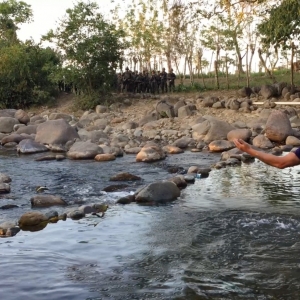Federal Water Tap, October 19: White House Order Formalizes Water Subcabinet
The Rundown
The Trump administration wants to coordinate water-related activities in the cabinet agencies. The EPA finalizes two rules that relax requirements for coal ash disposal. The EPA and other agencies work to develop a national map showing which wetlands and streams are regulated under the Clean Water Act. CDC researchers contribute to a study of handwashing and hygiene behaviors in the United States during the pandemic. USAID awards a consulting firm a $24 million contract for a water management program in Central Asia. And lastly, U.S. Geological Survey researchers find high salt concentrations in brines from the natural gas-producing formation known as the Utica shale.
“I am optimistic that we can reach agreement before the election. To that end, we are writing language as we negotiate the priorities, so that we are fully prepared to move forward once we reach agreement.” — Rep. Nancy Pelosi, speaker of the House, in a note to colleagues on October 18 about coronavirus relief bill talks. Pelosi set a Tuesday deadline for a pre-election deal.
By the Numbers
$24 million: Contract awarded by USAID to the consulting firm Tetra Tech for a five-year water resources management program in Central Asia. The program objective is to promote sustainable management of shared river systems in order to reduce regional conflict and aid economic growth and healthy ecosystems. Countries include Kazakhstan, Kyrgyzstan, Tajikistan, Turkmenistan, and Uzbekistan.
News Briefs
Water Subcabinet
President Trump signed an executive order that formalizes interagency collaboration on water policy.
The order establishes a “water subcabinet,” a term that administration officials have used for several years to refer to the leaders of agencies that are involved in water issues.
According to the order, the members will collaborate to carry out the administration’s water objectives, notably increasing water storage, streamlining the permitting process, promoting market-based programs, water reuse, data analysis, and developing the next generation of water sector professionals.
Members of the subcabinet include:
- Department of the Interior Assistant Secretary of Water and Science Tim Petty
- EPA Assistant Administrator for Water David Ross
- U.S. Department of Agriculture Under Secretary for Farm Production and Conservation Bill Northey
- Assistant Secretary of the Army for Civil Works R.D. James
- U.S. Department of Energy Assistant Secretary for the Office of Energy Efficiency and Renewable Energy Daniel Simmons
- Deputy National Oceanic and Atmospheric Administration Administrator Rear Admiral Tim Gallaudet
Trillion Trees Group
In addition to the water announcement, the president also established a cabinet-level council to guide federal tree policy.
The One Trillion Trees Interagency Council will focus identifying ways to restore and conserve the nation’s forests and to track progress in that regard.
Coal Ash Rules Finalized
The EPA finalized two rules regarding the disposal of toxic waste from burning coal.
One rule gives coal power plants that plan to close or switch away from coal by 2028 more time to comply with regulations. Those regulations refer to disposal of two waste streams: water from scrubbers that remove sulfur dioxide from air emissions and water from bottom ash, which is the coal that falls to the bottom of the burners.
The other rule deals with the liners used at the bottom of coal ash pits to prevent seepage of heavy metals into groundwater.
The rule allows power plant operators to request an exemption from using one of the mandated liner types. Exemptions will be granted, even to unlined pits, based on site evaluations and evidence that the pits “pose no reasonable probability of adverse effects to human health or the environment.”
The EPA is also seeking comments and expertise for a future coal ash rulemaking. The agency wants information on “legacy” coal ash pits at closed power stations: their location, status, and what rules should apply to them.
Studies and Reports
Mapping WOTUS
The EPA and other federal agencies are developing a national map that shows which streams and wetlands are regulated by the Clean Water Act.
Several national data sets exist for wetlands and waterways, but it is the agency’s position that none depicts accurately the boundaries of federal regulatory authority.
Handwashing Survey Says…
Among U.S. adults above age 18, washing and sanitizing hands is less prevalent for younger people, males, and those with lower incomes.
That’s according to a survey conducted by a group of scientists that includes CDC researchers.
A possible explanation for the discrepancy in hygiene behaviors in the midst of the pandemic is the perception of risk, the researchers said. Other studies this year have indicated that males and young adults think their odds of catching the virus are low. Another explanation is that low-income people might be more reluctant to buy hand sanitizer.
More than 5,400 U.S. adults filled out the internet-based survey in the last week of June. The survey, which used self-reported data, is part of the COVID-19 Outbreak Public Evaluation initiative, a project to understand the public’s attitudes, behaviors, and responses to the pandemic.
National Groundwater Use
Some 84.6 billion gallons of water a day were pumped from the nation’s aquifers in 2015, according to a U.S. Geological Survey assessment. Ninety-four percent of the total came from 66 principal aquifers.
The aquifers with the highest amount of pumping coincide with major farming regions: the High Plains, the Mississippi Valley, and California’s Central Valley. Two-thirds of groundwater withdrawals nationally were for agriculture.
In context: U.S. Irrigation Continues Steady Eastward Expansion
Water Quality in the Utica Shale
Oil and gas production has a companion: lots of salty water that is drawn to the surface along with the hydrocarbons.
Little is known about the brines associated with the Utica shale formation, a natural gas play centered in eastern Ohio and western Pennsylvania. Their chemical composition is an important factor for safe disposal.
U.S. Geological Survey researchers analyzed the brine from 16 oil or gas wells in the Utica region. They found high levels of various salts, including radioactive radium.
The region’s wastewater is also a prodigious source of salts. The researchers estimate that in 2018 all the Utica wells produced just under 1.4 million tons of salt, roughly equal to 3.4 percent of all commercial U.S. salt production.
The researchers note that because of these salt concentrations and properties, “care needs to be taken” for disposing of Utica wastewater.
The study was published in the journal Environmental Science and Technology.
On the Radar
Great Lakes Advisory Board
On October 29, the Great Lakes Advisory Board will hold a public virtual meeting. The board advises federal agencies on Great Lakes issues.
Great Lakes Water Levels Webinar
On November 2, NOAA and its partners will hold a public webinar to discuss the seasonal outlook for Great Lakes water levels, which have set record highs this year.
Federal Water Tap is a weekly digest spotting trends in U.S. government water policy. To get more water news, follow Circle of Blue on Twitter and sign up for our newsletter.
Brett writes about agriculture, energy, infrastructure, and the politics and economics of water in the United States. He also writes the Federal Water Tap, Circle of Blue’s weekly digest of U.S. government water news. He is the winner of two Society of Environmental Journalists reporting awards, one of the top honors in American environmental journalism: first place for explanatory reporting for a series on septic system pollution in the United States(2016) and third place for beat reporting in a small market (2014). He received the Sierra Club’s Distinguished Service Award in 2018. Brett lives in Seattle, where he hikes the mountains and bakes pies. Contact Brett Walton






Leave a Reply
Want to join the discussion?Feel free to contribute!